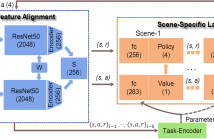- Image/Video Storage, Retrieval
- Image/Video Processing
- Image/Video Coding
- Image Scanning, Display, and Printing
- Image Formation

- Read more about MOTION SALIENCY BASED GENERATIVE ADVERSARIAL NETWORK FOR UNDERWATER MOVING OBJECT SEGMENTATION
- Log in to post comments
The underwater moving object segmentation is a challenging task. The problems like absorbing, scattering and attenuation of light rays between the scene and the imaging platform degrades the visibility of image or video frames. Also, the back-scattering of light rays further increases the problem of underwater video analysis, because the light rays interact with underwater particles and scattered back to the sensor. In this paper, a novel Motion Saliency Based Generative Adversarial Network (GAN) for Underwater Moving Object Segmentation (MOS) is proposed.
- Categories:
 24 Views
24 Views
- Read more about MOTION SALIENCY BASED GENERATIVE ADVERSARIAL NETWORK FOR UNDERWATER MOVING OBJECT SEGMENTATION
- Log in to post comments
The underwater moving object segmentation is a challenging task. The problems like absorbing, scattering and attenuation of light rays between the scene and the imaging platform degrades the visibility of image or video frames. Also, the back-scattering of light rays further increases the problem of underwater video analysis, because the light rays interact with underwater particles and scattered back to the sensor. In this paper, a novel Motion Saliency Based Generative Adversarial Network (GAN) for Underwater Moving Object Segmentation (MOS) is proposed.
Poster.pdf
- Categories:
 11 Views
11 Views
- Read more about MOTION SALIENCY BASED GENERATIVE ADVERSARIAL NETWORK FOR UNDERWATER MOVING OBJECT SEGMENTATION
- Log in to post comments
The underwater moving object segmentation is a challenging task. The problems like absorbing, scattering and attenuation of light rays between the scene and the imaging platform degrades the visibility of image or video frames. Also, the back-scattering of light rays further increases the problem of underwater video analysis, because the light rays interact with underwater particles and scattered back to the sensor. In this paper, a novel Motion Saliency Based Generative Adversarial Network (GAN) for Underwater Moving Object Segmentation (MOS) is proposed.
Poster.pdf
- Categories:
 40 Views
40 Views
- Read more about MOTION SALIENCY BASED GENERATIVE ADVERSARIAL NETWORK FOR UNDERWATER MOVING OBJECT SEGMENTATION
- Log in to post comments
The underwater moving object segmentation is a challenging task. The problems like absorbing, scattering and attenuation of light rays between the scene and the imaging platform degrades the visibility of image or video frames. Also, the back-scattering of light rays further increases the problem of underwater video analysis, because the light rays interact with underwater particles and scattered back to the sensor. In this paper, a novel Motion Saliency Based Generative Adversarial Network (GAN) for Underwater Moving Object Segmentation (MOS) is proposed.
Poster.pdf
Poster.pdf
- Categories:
 36 Views
36 Views
- Read more about Single Image Depth Estimation Using Deep Adversarial Training
- Log in to post comments
Scene understanding is an active area of research in computer vision that encompasses several different problems. The LiDARs and stereo depth sensor have their own restrictions such as light sensitiveness, power consumption and short-range. In this paper, we propose a two-stream deep adversarial network for single image depth estimation in RGB images. For stream I network, we propose a novel encoder-decoder architecture using residual concepts to extract course-level depth features.
- Categories:
 32 Views
32 Views
- Read more about Fashion Recommendation on Street Images
- Log in to post comments
Learning the compatibility relationship is of vital importance to a fashion recommendation system, while existing works achieve this merely on product images but not on street images in the complex daily life scenario. In this paper, we propose a novel fashion recommendation system: Given a query item of interest in the street scenario, the system can return the compatible items. More specifically, a two-stage curriculum learning scheme is developed to transfer the semantics from the product to street outfit images.
- Categories:
 23 Views
23 Views
- Read more about MEMORY-BASED PARAMETERIZED SKILLS LEARNING FOR MAPLESS VISUAL NAVIGATION
- Log in to post comments
The recently-proposed reinforcement learning for mapless visual navigation can generate an optimal policy for searching different targets. However, most state-of-the-art deep reinforcement learning (DRL) models depend on hard rewards to learn the optimal policy, which can lead to the lack of previous diverse experiences. Moreover, these pre-trained DRL models cannot generalize well to un-trained tasks. To overcome these problems above, in this paper, we propose a Memorybased Parameterized Skills Learning (MPSL) model for mapless visual navigation.
- Categories:
 52 Views
52 Views
- Read more about COMPRESSIVE SENSING RECONSTRUCTION BASED ON STANDARDIZED GROUP SPARSE REPRESENTATION
- Log in to post comments
Non-local sparsity has been widely concerned in image compressive
sensing. Considering the difference of distribution
characteristic of among group-based sparse coefficients of
image, a new method for image compressive sensing reconstruction
(ICSR) is proposed based on the z-scores standardized
group sparse representation (ZSGSR). Here, the
similar patch groups of the image are firstly extracted and
decomposed by adaptive PCA dictionary, then the resulting
coefficients are normalized using z-score standardization in
- Categories:
 40 Views
40 Views
- Read more about Denoising Adversarial Networks for Rain Removal and Reflection Removal
- 1 comment
- Log in to post comments
poster1192.pdf
- Categories:
 28 Views
28 Views
- Read more about CLUSTERING IMAGES BY UNMASKING - A NEW BASELINE
- Log in to post comments
- Categories:
 22 Views
22 Views